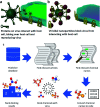Antiviral nanoparticle ligands identified with datamining and high-throughput virtual screening
- PMID: 35480438
- PMCID: PMC9034338
- DOI: 10.1039/d1ra02293h
Antiviral nanoparticle ligands identified with datamining and high-throughput virtual screening
Abstract
To help contain the spread of the COVID-19 pandemic and to protect front-line workers, new antiviral measures are required. Antiviral nanoparticles are one such possible measure. Metal nanoparticles made from a variety of metals including gold, silver, and copper can kill or disable viruses that cause significant health problems in humans (such as SARS-CoV-2, HIV, or influenza). To promote interaction between nanoparticles and viruses the stabilizing ligands on the nanoparticle surface should be optimized for docking with proteins. The enormous chemical space of possible nanoparticle ligands makes this optimization experimentally and computationally intractable. Here we present a datamining-based study that searched for nanoparticle ligands that have previously been used, and computationally tested these for their ability to dock with the SARS-CoV-2 spike glycoprotein. These ligands will coat future antiviral nanoparticles to be used outside of the body, not as drugs. The best of these ligands identified were: nitric acid (score: 0.95), phosphoroselenoic acid (score: 0.88), hydroxyammonium (score: 0.83), pyrophosphoric acid (score: 0.81). Inspection of the best of these ligands has suggested design principles for future antiviral nanoparticle ligands, and we suggest further ligands based on these principles. These results will be used to inspire further in vitro and in silico experimentation to accelerate the development of antiviral nanoparticles.
This journal is © The Royal Society of Chemistry.
Conflict of interest statement
There are no conflicts to declare.
Figures




Similar articles
-
Chemical Nature of Metals and Metal-Based Materials in Inactivation of Viruses.Nanomaterials (Basel). 2022 Jul 8;12(14):2345. doi: 10.3390/nano12142345. Nanomaterials (Basel). 2022. PMID: 35889570 Free PMC article. Review.
-
Discovery of Potent SARS-CoV-2 Inhibitors from Approved Antiviral Drugs via Docking and Virtual Screening.Comb Chem High Throughput Screen. 2021;24(3):441-454. doi: 10.2174/1386207323999200730205447. Comb Chem High Throughput Screen. 2021. PMID: 32748740
-
Development and Evaluation of Peptidomimetic Compounds against SARS-CoV-2 Spike Protein: An in silico and in vitro Study.Mol Inform. 2022 Jul;41(7):e2100231. doi: 10.1002/minf.202100231. Epub 2022 Feb 1. Mol Inform. 2022. PMID: 35068079 Free PMC article.
-
A simple cost-effective microfluidic platform for rapid synthesis of diverse metal nanoparticles: A novel approach towards fighting SARS-CoV-2.Mater Today Proc. 2023;80:1852-1857. doi: 10.1016/j.matpr.2021.05.624. Epub 2021 Jun 14. Mater Today Proc. 2023. PMID: 34150529 Free PMC article.
-
Neutralization of SARS-CoV-2 Spike Protein via Natural Compounds: A Multilayered High Throughput Virtual Screening Approach.Curr Pharm Des. 2020;26(41):5300-5309. doi: 10.2174/1381612826999200820162937. Curr Pharm Des. 2020. PMID: 32867645
Cited by
-
Silver Nanoparticles-Functionalized Textile against SARS-CoV-2: Antiviral Activity of the Capping Oleylamine Molecule.ACS Appl Mater Interfaces. 2025 Jan 29;17(4):5710-5718. doi: 10.1021/acsami.4c15289. Epub 2025 Jan 14. ACS Appl Mater Interfaces. 2025. PMID: 39807796 Free PMC article.
-
Chemical Nature of Metals and Metal-Based Materials in Inactivation of Viruses.Nanomaterials (Basel). 2022 Jul 8;12(14):2345. doi: 10.3390/nano12142345. Nanomaterials (Basel). 2022. PMID: 35889570 Free PMC article. Review.
References
LinkOut - more resources
Full Text Sources
Miscellaneous

